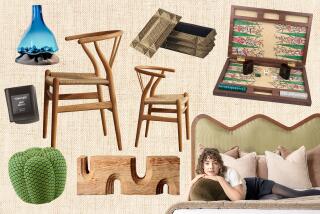In Paris, Culture Is in the House
PARIS — You might have thought, watching the quiet couples strolling past the antique and futuristic furniture Saturday at the Paris Expo at the Porte de Versailles, that the Salon du Meuble--the annual furnishings show--was a museum exhibition, and not one of the world’s largest furniture shows.
“It’s a market, but it is also a cultural event,” said spokeswoman Christine Milhoud, adding that it is forbidden for money to change hands at the market. The thrust of this 20th annual show, which ran Thursday through Monday, was the France of yesterday and tomorrow, but about half the 1,500 exhibitors were from outside France, presenting a range of mass-market, low-end furniture and accessories to high-end, cutting-edge design.
The terrorist attacks of Sept. 11 initially prompted some cancellations from international exhibitors, Milhoud said, but in the end didn’t seem to have much impact on attendance. “We were very worried, but in fact I think we were more worried than was necessary,” she said. As in past years, there were no Americans offering their wares. Director Patrick Renaud, who has headed the Salon for nine years, said that because of the dollar’s strength, it doesn’t make economic sense for Europeans to import American goods. On the other hand, some 600 of the 55,000 professional buyers here were from the U.S.
“American buyers [here] are usually interested in classic looks that correspond with the image the world has of France, not in contemporary furniture,” he said, although he pointed out that this is less true of buyers from the Western U.S. than Easterners.
Plenty of classic French furniture was on hand as well, and organizers responded to the craze for all things Deco with the exhibition “The French Line: The Art of Living in the Normandy Days,” inspired by the 1930s luxury liner that sailed from Le Havre to New York. Along with reproductions and new versions of the period’s furniture, lighting, textile and floor coverings, it featured a display of original pieces from the ‘30s and ‘40s--from old Louis Vuitton steamer trunks to Lalique glassware to the ubiquitous club chairs that have become so popular in the last several years, on loan from various French galleries, museums and designer shops.
The Salon was also notable for its attention to contemporary design. Organizers insist that this year’s showing proves that young French designers are now catching up with their Italian neighbors, once the undisputed leaders of the avant-garde, thanks to France’s strong design schools, technological advances made accessible via the Internet and a new openness and interest in cutting-edge design. Indeed, press reports on the show pointed to a renewed vitality in French contemporary design, and projects like the new Christian Liagre-designed Market restaurant seem to support the claims.
Eric Berthes, a 29-year-old French product designer, said he used his knowledge of rubber and plastic to reimagine furniture, including prototypes for a series of distinctively shaped, bright red aluminum and rubber indoor-outdoor lounges. Christian de Riviere, who has been in charge of the avant-garde segment of the show for the last few years, said that this year “there is more rigor in terms of line, a return to well-finished pieces using more technological materials, more color and transparency and translucency. Things are designed to be a bit sculptural now, playful but practical.” He pointed to a felt lampshade, a boomerang-shaped fish tank, a fuchsia “butterfly chair” made of Dacryl by the French designer Christian Ghion or a “meditation pod” shaped like a lucky clover by the Dutch designer Steven Blaess .
And while the French tend to change residences far less frequently than Americans, modular or lightweight furniture that can be transported easily was a big trend. “We do move house much less often than Americans,” De Riviere said, “but now we can change house without leaving the same apartment.” And transparent materials can help make the small spaces that Europeans generally live in seem larger. New designers are now treating furniture like fashion, not as permanent pieces to be passed on to heirs.
Fusion is still a fresh concept in a country with such loyal historical traditions, where young designers and consumers have begun to look everywhere for ideas. An exhibition called “Toward New Styles of Living--Worldwide” featured a selective group of 12 ambitious designers from five continents, including colored garden-hose-covered “anemone” chairs from Brazilian brothers Humberto and Fernando Campana and Turkish, New York-based designer Ayse Birsel’s reimagined bidet and work pods.
Much of the text accompanying the show’s catalog examined the effects of globalization on the living room or the bedroom. But De Riviere pointed out that world style does not have to mean the homogenization of taste. The “Cool” black Styrofoam-stuffed transparent pillows of Japanese designer Masayo Ave might be scattered on the floor in a Minimalist apartment in Tokyo, but set atop an antique divan in Paris, they create a completely different effect. “It’s design that travels, and we reinterpret it according to our culture,” De Riviere said. “It’s nomad furniture.”


